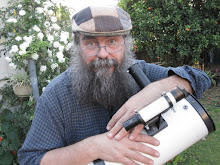Friday, April 25, 2025
Seeing Vesta at Opposition (2 May 2025)
| Evening sky on Friday, May 2 as seen from Adelaide at 23:00 ACST. Asteroid Vesta is at apposition in Libra. The inset is the binocular view of Vesta at this time. At magnitude 5.7 it will be an easy binocular object near clear guide stars. Similar views will be seen elsewhere in Australia at the equivalent local time. | The approximate wide field binocular view of Vesta and the guide stars at 23:00 ACST from Friday, April 25 on with the track of Vesta shown (click to embiggen, similar views will be seen elsewhere at the equivalent local time). |
| Black and white horizon chart facing North suitable for printing showing the guide objects of 4 Vesta, Antares, 𝛃 Librae (Zubeneschamali), μ Virginis (Rijl Al Awwa, unlabeled in this view) and Arcturus as seen from Adelaide at 23:00 ACST at Saturday 25 April. Similar views will be seen elsewhere in Australia at the equivalent local time. Use the charts above to orient yourself to get to the guide stars. | Black and white binocular chart suitable for printing showing the movement of 4 Vesta over April-May. The large circle represents the field of view of 10x50 binoculars. Click to embiggen and print. Use the horizon chart to the left for orientation first. |
The Asteroid 4 Vesta is one of the iconic minor planets, and
one of two orbited by the Dawn spacecraft. At favorable
oppositions Vesta is bright enough to be seen with the unaided eye under dark
sky conditions. This year it gets to magnitude 5.7 just over unaided eye visibility at dark sky sites. Not really visible from suburban skies, but it will be easily visible in binoculars and small telescopes.
This year Friday, May 2 is a good opposition of Vesta, when it will
reach a magnitude of 5.7 at its brightest with reasonable guide stars and no Moon interference.
The waxing Moon will interfere later in the month, but now there is no Moon interference up to opposition allowing Vesta and its guide stars to be easily seen.
Labels: 4 Vesta, Asteroid, binocular





 Click to read about or order
Click to read about or order Click to read about or order
Click to read about or order Click to read about or order
Click to read about or order Click to read about or order
Click to read about or order